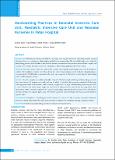Please use this identifier to cite or link to this item:
https://hdl.handle.net/20.500.14356/1623Full metadata record
| DC Field | Value | Language |
|---|---|---|
| dc.contributor.author | Joshi, Suchita | - |
| dc.contributor.author | Amatya, Puja | - |
| dc.contributor.author | Poudel, Bibek | - |
| dc.contributor.author | Yadav, Saroj Adhikari | - |
| dc.date.accessioned | 2023-05-16T10:32:27Z | - |
| dc.date.available | 2023-05-16T10:32:27Z | - |
| dc.date.issued | 2017 | - |
| dc.identifier.citation | JoshiS., AmatyaP., PoudelB., & YadavS. A. (2017). Handwashing Practices in Neonatal Intensive Care Unit, Paediatric Intensive Care Unit and Neonatal Nurseries in Patan Hospital. Journal of Nepal Health Research Council, 15(1). https://doi.org/10.33314/jnhrc.v15i1.972 | en_US |
| dc.identifier.issn | Print ISSN: 1727-5482; Online ISSN: 1999-6217 | - |
| dc.identifier.uri | http://103.69.126.140:8080/handle/20.500.14356/1623 | - |
| dc.description | Original Article | en_US |
| dc.description.abstract | Abstract Background: Hand hygiene has been identified as the single most important factor in minimising hospital acquired infections. However, compliance of handwashing guidelines has remained low. The aim of this study was to study the handwashing practices in the Paediatric and Neonatal intensive care units and Neonatal nurseries in Patan Hospital, and secondly to re-evaluate the improvement on compliance of handwashing guidelines after intervention. Methods: Pre-intervention study was conducted by covertly observing the handwashing practices by the healthcare workers. The healthcare workers were then shown the video demonstrating correct methods of handwashing as recommended by World health organization. The cycle was completed by discretely re-observing the handwashing practices following intervention. Results: Sixty five samples were collected initially. Only 6 (9.2%) had completed all steps of handwashing correctly. Post- intervention, 51 samples were collected, out of which 35 (68.6%) had correctly completed all the steps. Following audio-visual demonstration, 100% correctly completed 8/10 steps of handwashing with soap and water. 8 (16%) failed to dry hands using a single use towel and 14 (28%) failed to turn off the tap using elbow. Post- intervention, 100% correctly completed 4/7 steps of handwashing using chlorhexidine. Four (15%) still failed to rub backs of fingers to opposite palm, eight (30%) failed to palm to palm with fingers interlaced, and rub thumb to opposite palm. Conclusions: Compliance in hand hygiene is low despite the known fact that it reduces nosocomial infections. However, a simple intervention like video demonstration can improve the compliance among healthcare workers. Keywords: Disinfection; handwashing; infection control; nosocomial infection. | en_US |
| dc.language.iso | en | en_US |
| dc.publisher | Nepal Health Research Council | en_US |
| dc.relation.ispartofseries | Jan-April, 2017;972 | - |
| dc.subject | Disinfection | en_US |
| dc.subject | Handwashing | en_US |
| dc.subject | Infection control | en_US |
| dc.subject | Nosocomial infection | en_US |
| dc.title | Handwashing Practices in Neonatal Intensive Care Unit, Paediatric Intensive Care Unit and Neonatal Nurseries in Patan Hospital | en_US |
| dc.type | Journal Article | en_US |
| local.journal.category | Original Article | - |
| Appears in Collections: | Vol. 15 No. 1 Issue 35 Jan-Apr 2017 | |
Files in This Item:
| File | Description | Size | Format | |
|---|---|---|---|---|
| 972-Manuscript-1889-2-10-20170611.pdf | Fulltext Download | 361.78 kB | Adobe PDF |  View/Open |
Items in DSpace are protected by copyright, with all rights reserved, unless otherwise indicated.
